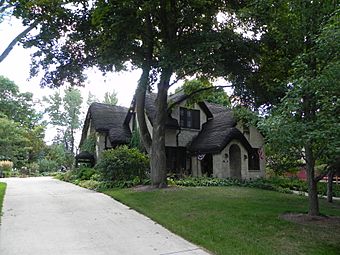Harold Hornburg House facts for kids
Quick facts for kids |
|
|
Harold Hornburg House
|
|

Harold Hornburg House
|
|
| Location | 213 Warren Ave., Hartland, Wisconsin |
|---|---|
| Area | less than one acre |
| Built | 1928 |
| Architect | Alexander C. Eschweiler/Harold Brockmeyer |
| Architectural style | Tudor Revival |
| MPS | Hartland MRA |
| NRHP reference No. | 86003431 |
| Added to NRHP | December 8, 1986 |
The Harold Hornburg House in Hartland, Wisconsin is a unique home built in 1928. It was designed to look like an old English cottage with a special "thatched" roof. This house is important because it was added to the National Register of Historic Places in 1986. This list includes buildings and places that are important to American history. It was also added to Wisconsin's State Register of Historic Places in 1989.
The Story of the House
Harold Hornburg was a businessman who sold Ford cars for many years. He wanted a special home, and he worked with the famous architect Alexander C. Eschweiler to design it. The house is one and a half stories tall.
Unique Design Features
The outside walls of the house are covered with a special kind of stone. It is called Lannon stone. This stone helps give the house its old-fashioned look.
One of the most interesting parts of the house is its roof. It has "rolled eaves," which are the parts of the roof that hang over the walls. These eaves are shaped in a way that makes the roof look like it's made of straw or reeds, like a traditional "thatched roof." Even though it looks like thatch, it's actually covered with modern shingles.
Harold Hornburg and his builder, Harold Brockmeyer, got the idea for this roof from another house they saw in Oshkosh. The way the house sits low to the ground, without a tall basement, also makes it look like a charming Cotswold cottage. Cotswold cottages are famous for their cozy, old-world style found in England.
Why This House is Historic
The Harold Hornburg House is a great example of Tudor Revival style. This style became popular in the United States in the early 1900s. It brought back the look of homes from the Tudor period in England.
Being on the National Register of Historic Places means the house is protected. It is recognized as a valuable part of our history and culture. It helps us remember how people lived and what kind of buildings were popular in the past.

